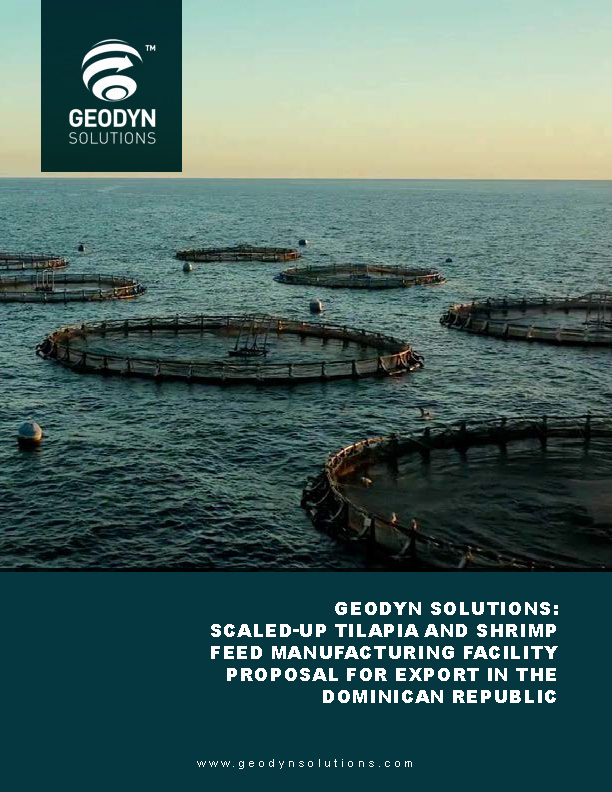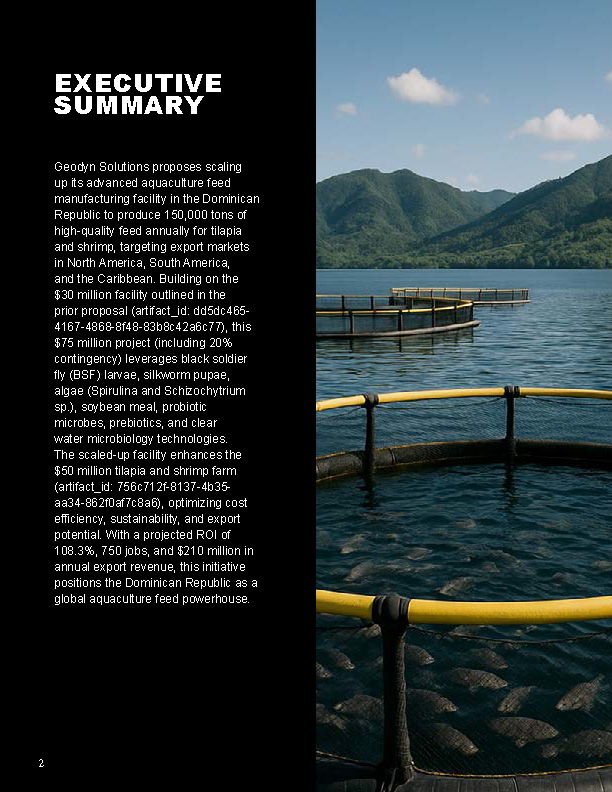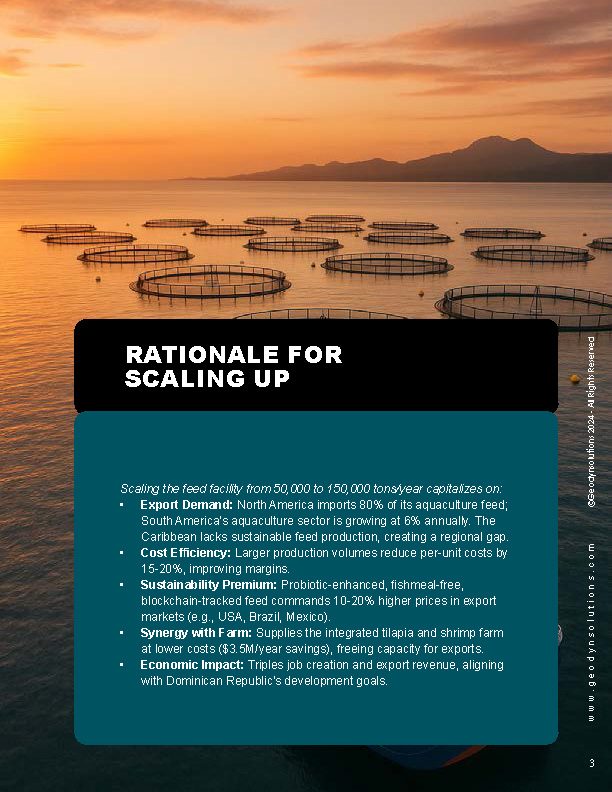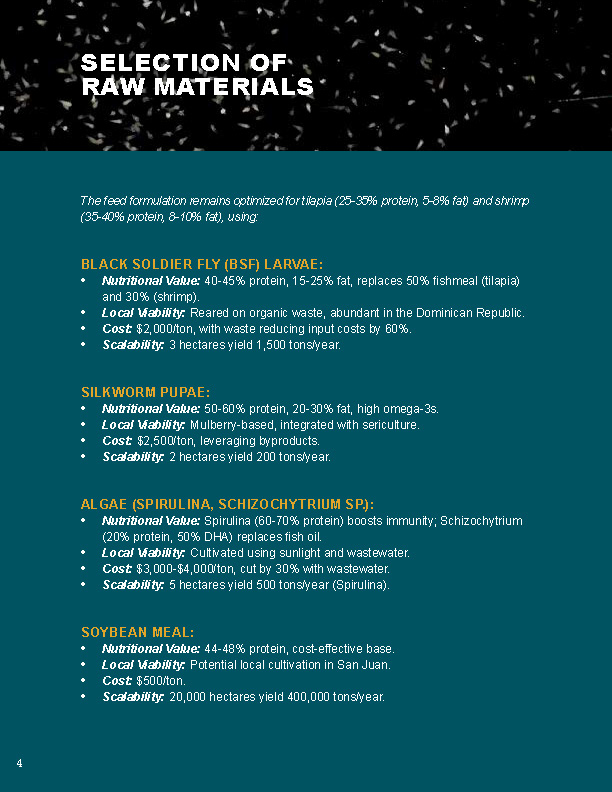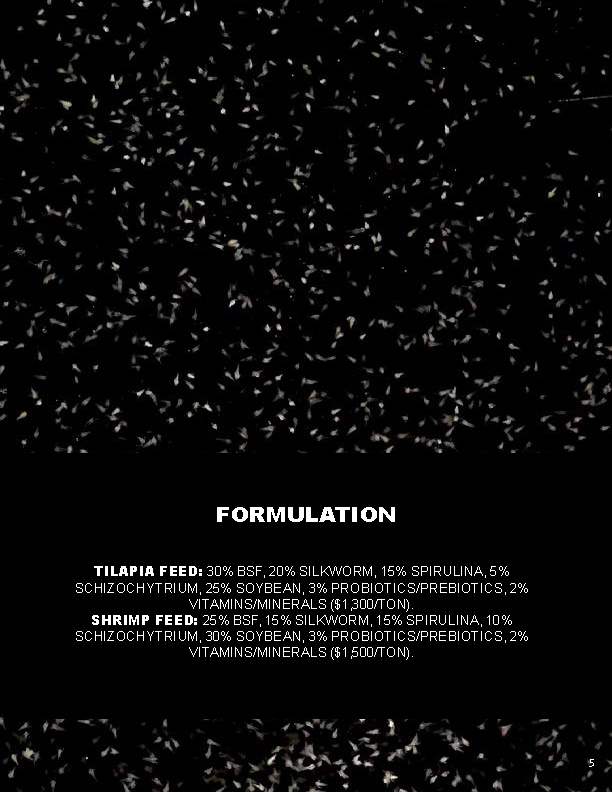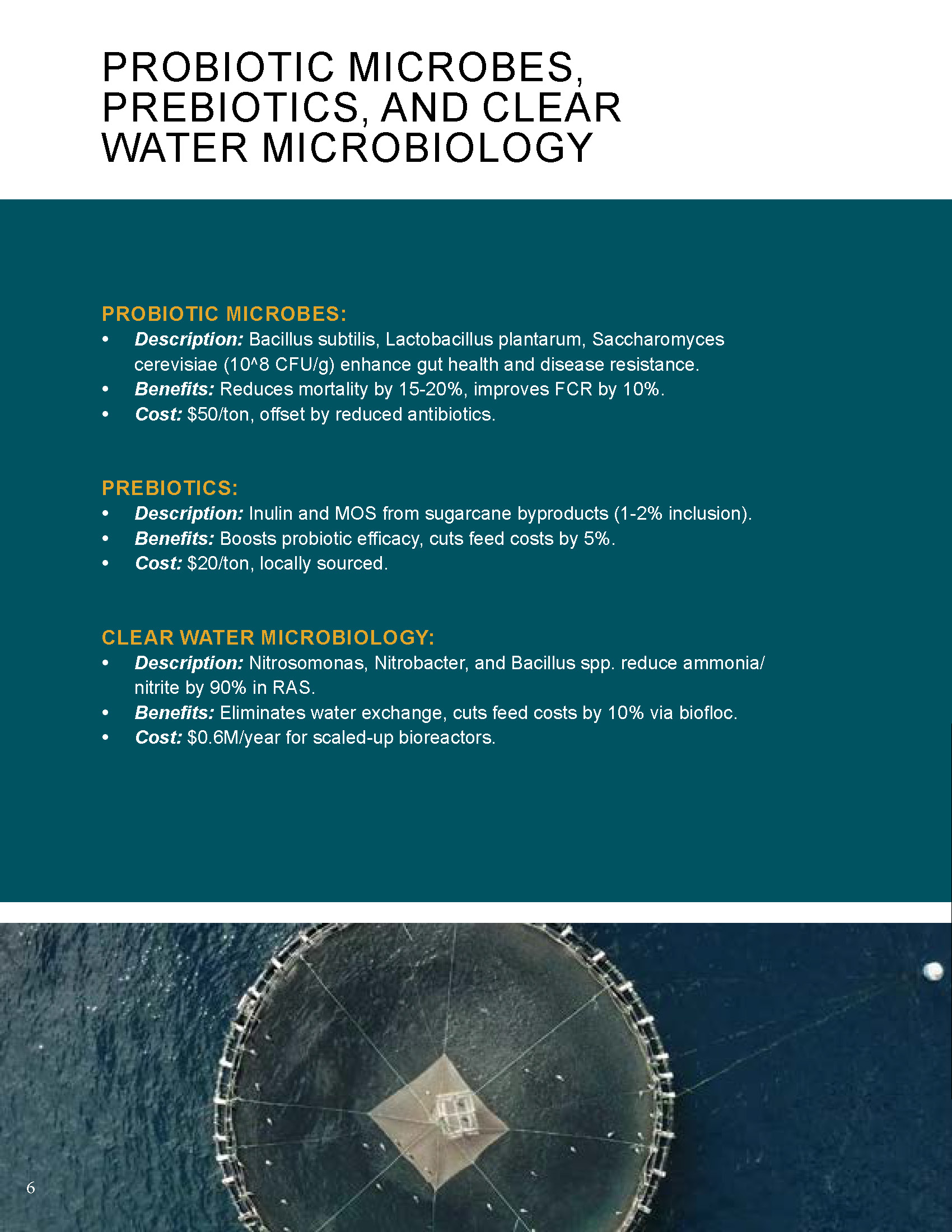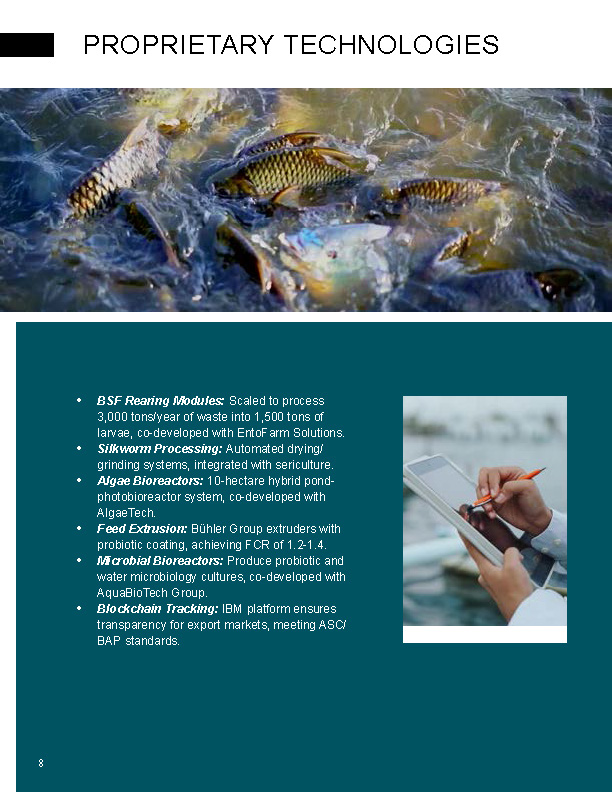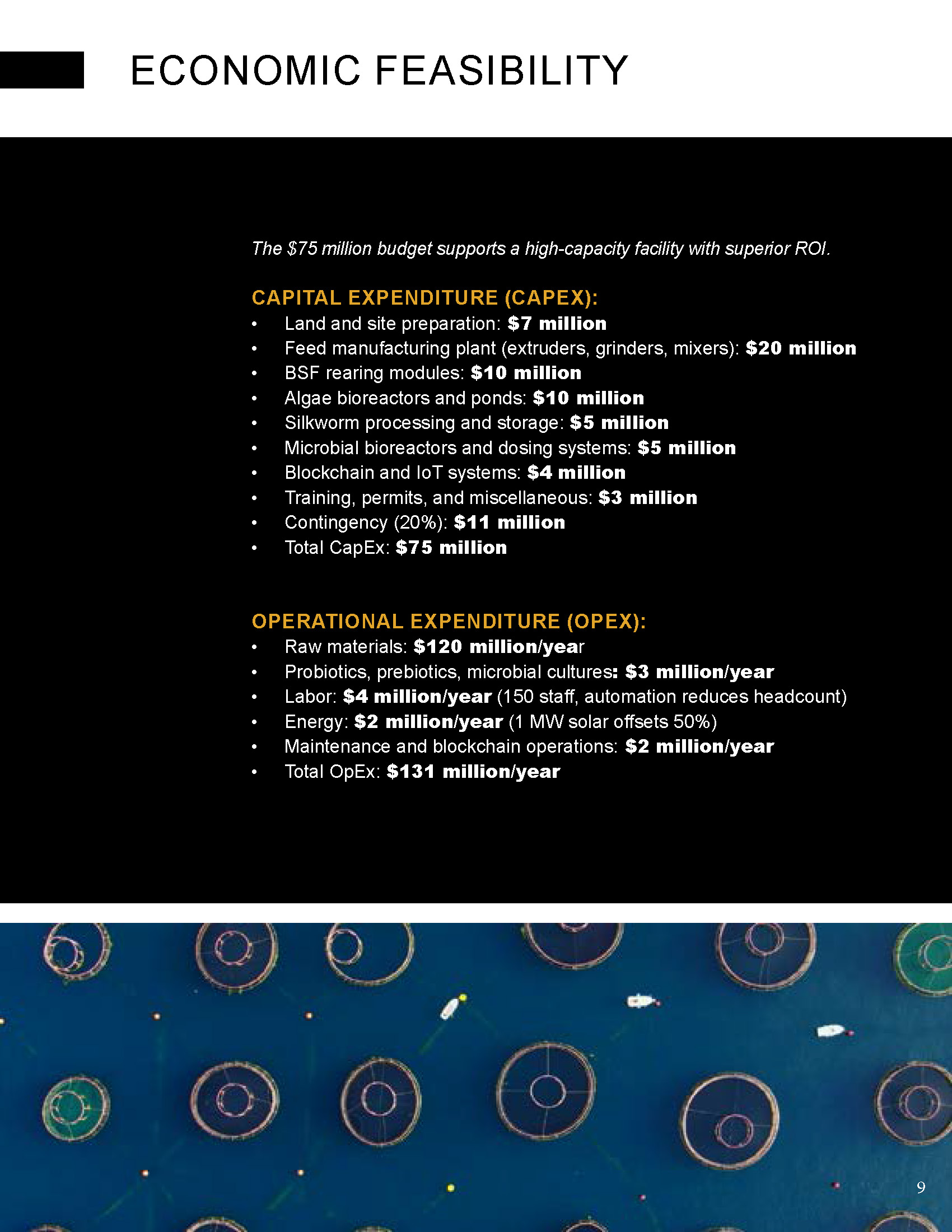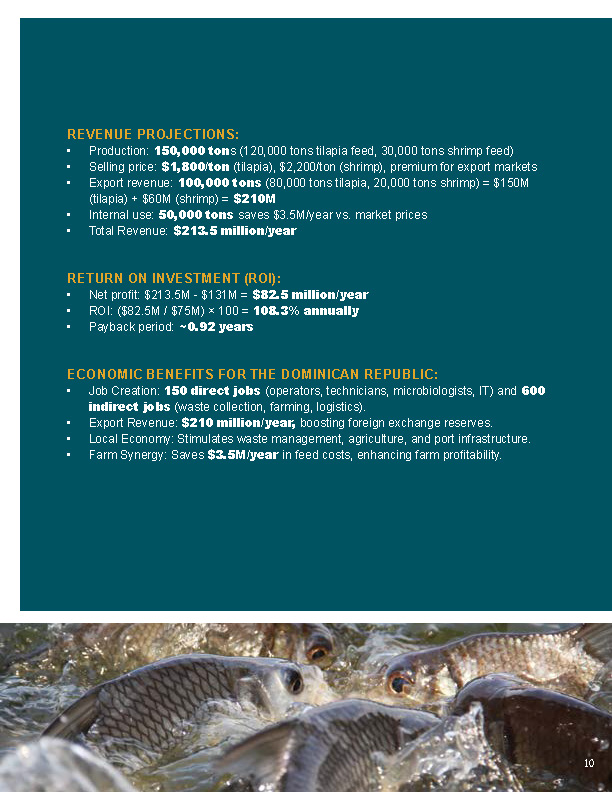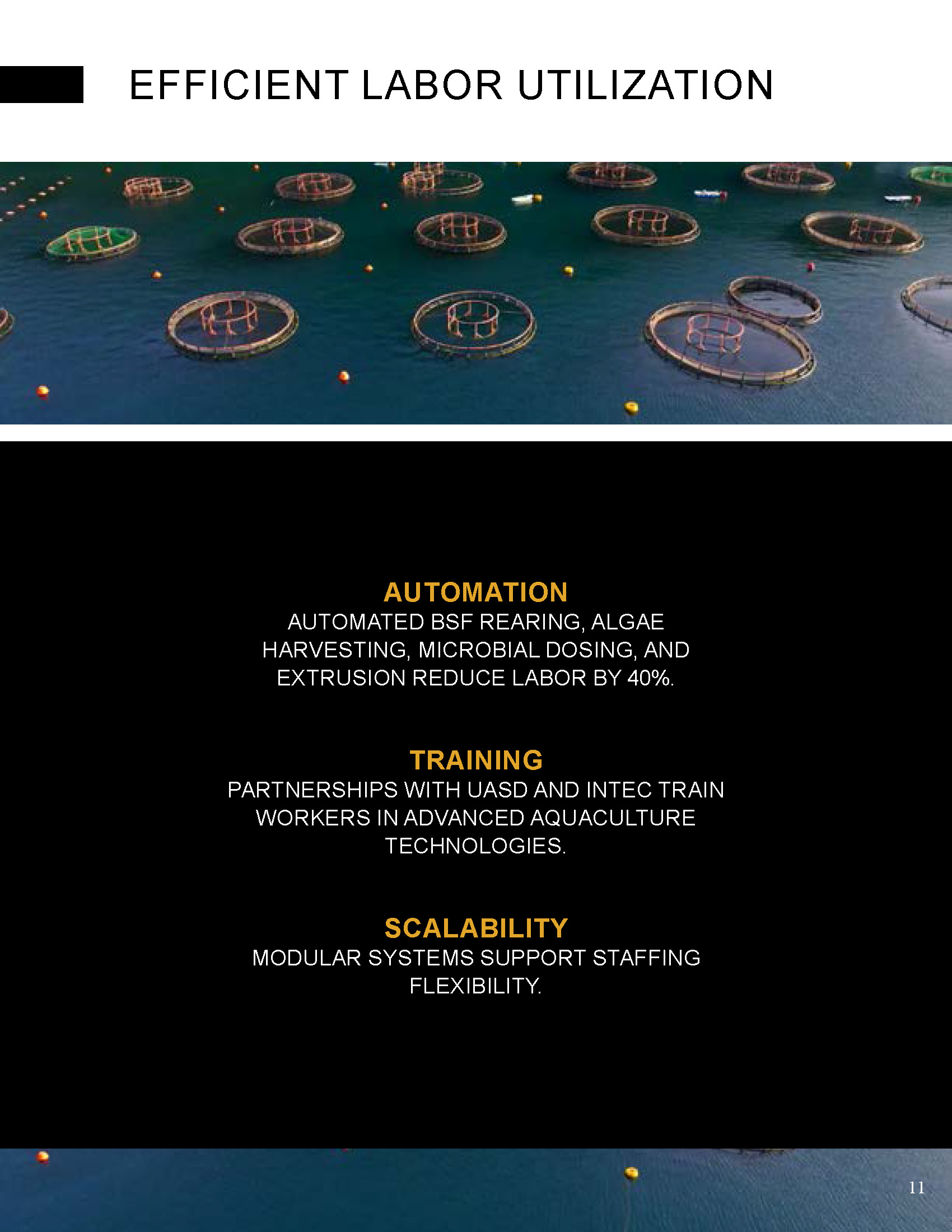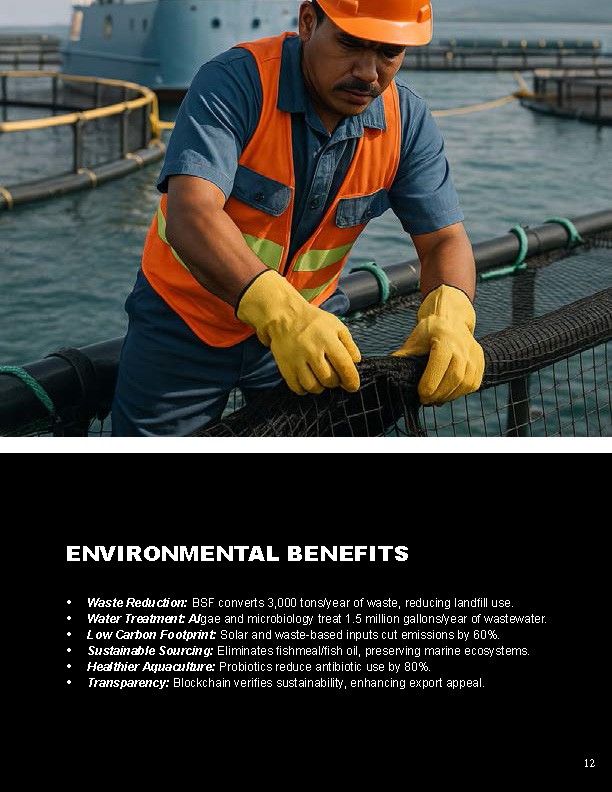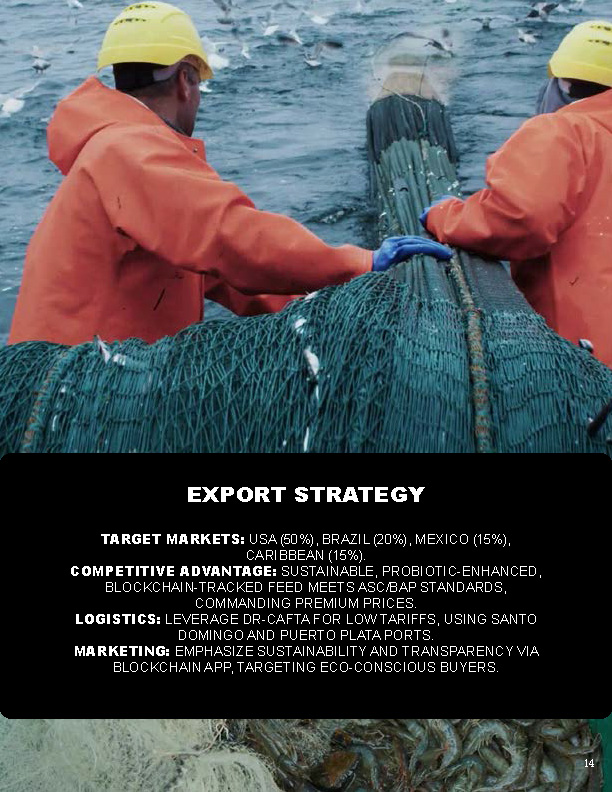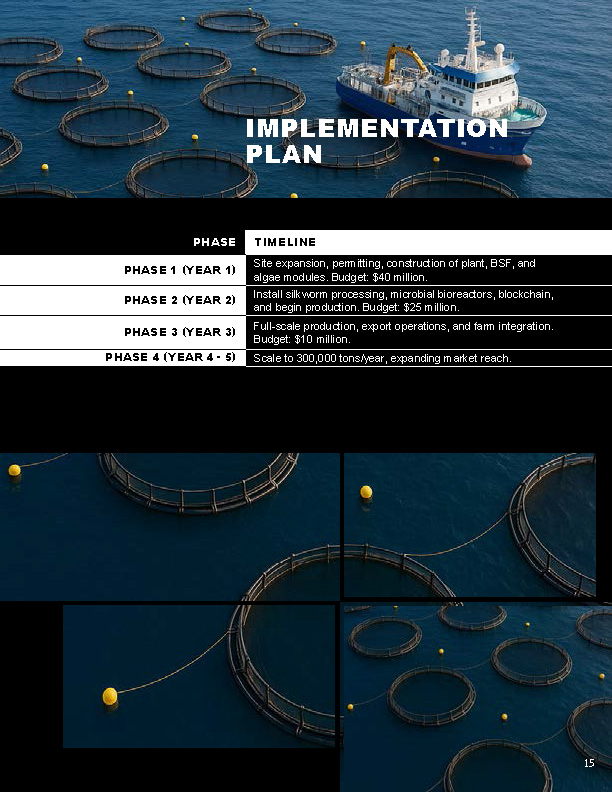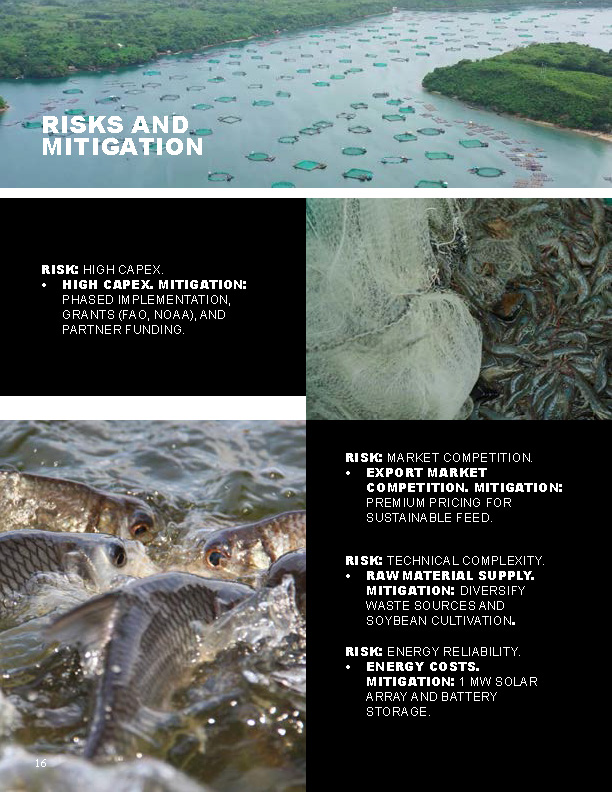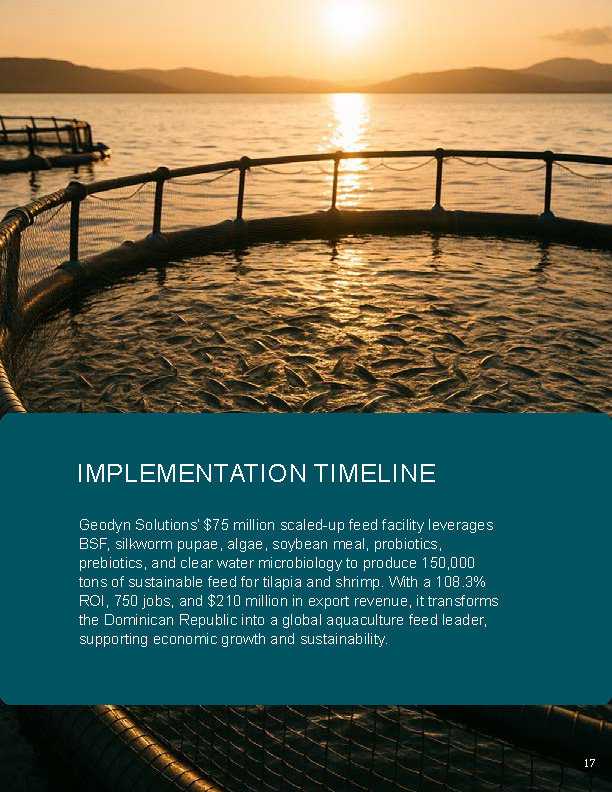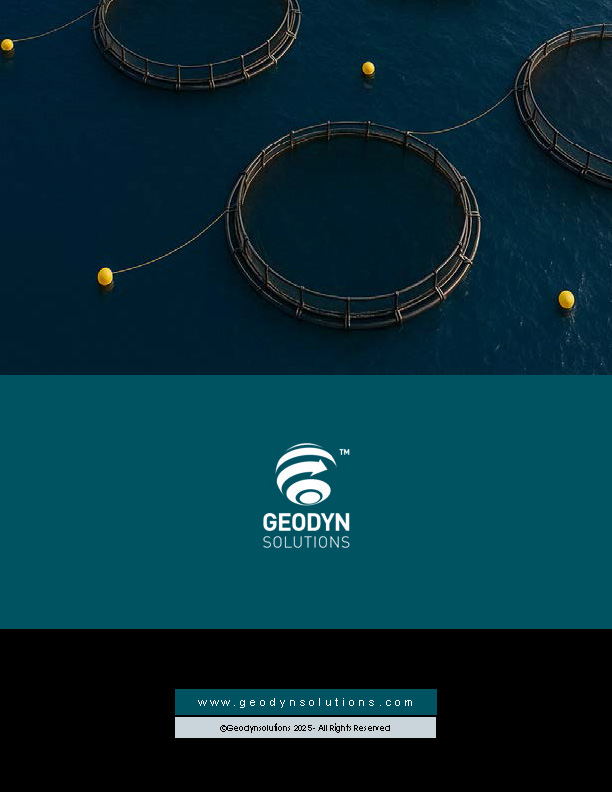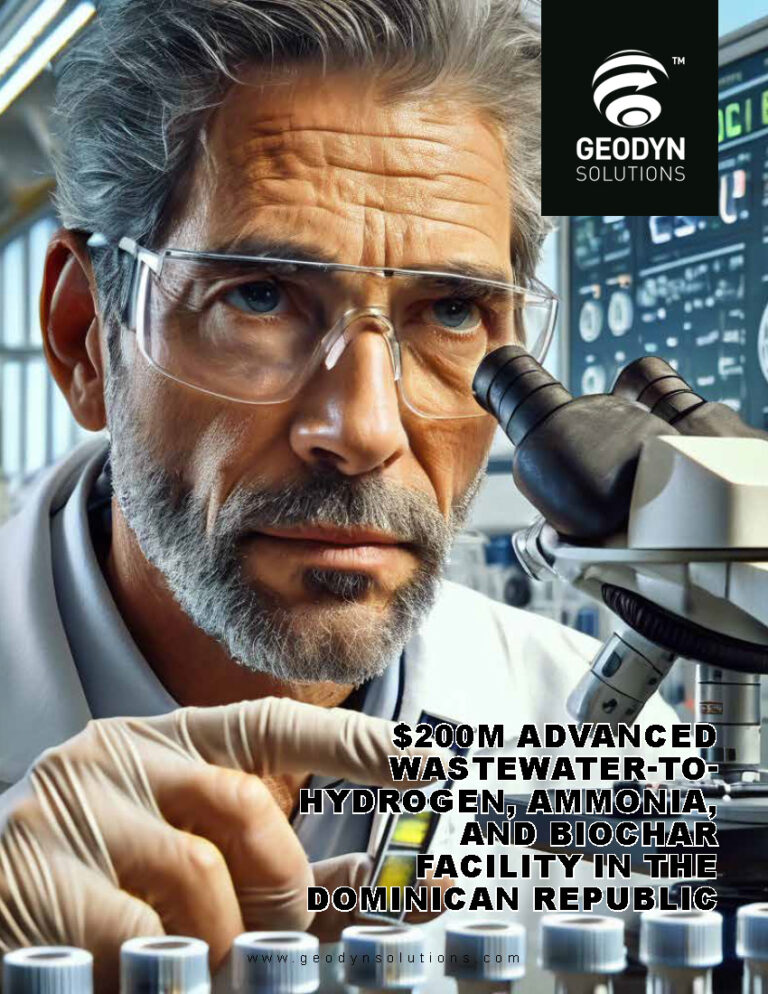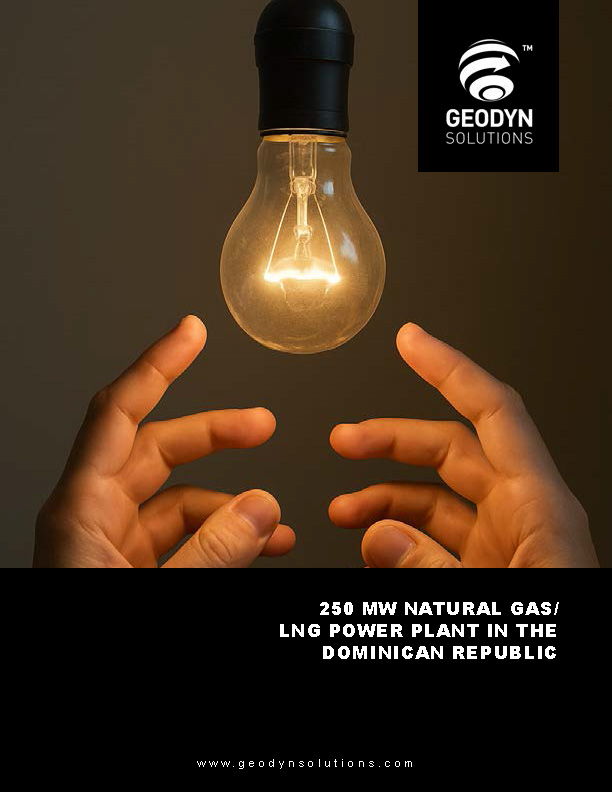Geodyn Solutions: Scaled-Up Tilapia and Shrimp Feed Manufacturing Facility Proposal for Export in the Dominican Republic
Executive Summary
Geodyn Solutions proposes scaling up its advanced aquaculture feed manufacturing facility in the Dominican Republic to produce 150,000 tons of high-quality feed annually for tilapia and shrimp, targeting export markets in North America, South America, and the Caribbean. Building on the $30 million facility outlined in the prior proposal (artifact_id: dd5dc465-4167-4868-8f48-83b8c42a6c77), this $75 million project (including 20% contingency) leverages black soldier fly (BSF) larvae, silkworm pupae, algae (Spirulina and Schizochytrium sp.), soybean meal, probiotic microbes, prebiotics, and clear water microbiology technologies. The scaled-up facility enhances the $50 million tilapia and shrimp farm (artifact_id: 756c712f-8137-4b35-aa34-862f0af7c8a6), optimizing cost efficiency, sustainability, and export potential. With a projected ROI of 108.3%, 750 jobs, and $210 million in annual export revenue, this initiative positions the Dominican Republic as a global aquaculture feed powerhouse.
Rationale for Scaling Up
Scaling the feed facility from 50,000 to 150,000 tons/year capitalizes on:
- Export Demand: North America imports 80% of its aquaculture feed; South America’s aquaculture sector is growing at 6% annually. The Caribbean lacks sustainable feed production, creating a regional gap.
- Cost Efficiency: Larger production volumes reduce per-unit costs by 15-20%, improving margins.
- Sustainability Premium: Probiotic-enhanced, fishmeal-free, blockchain-tracked feed commands 10-20% higher prices in export markets (e.g., USA, Brazil, Mexico).
- Synergy with Farm: Supplies the integrated tilapia and shrimp farm at lower costs ($3.5M/year savings), freeing capacity for exports.
- Economic Impact: Triples job creation and export revenue, aligning with Dominican Republic’s development goals.
Selection of Raw Materials
The feed formulation remains optimized for tilapia (25-35% protein, 5-8% fat) and shrimp (35-40% protein, 8-10% fat), using:
- Black Soldier Fly (BSF) Larvae:
- Nutritional Value: 40-45% protein, 15-25% fat, replaces 50% fishmeal (tilapia) and 30% (shrimp).
- Local Viability: Reared on organic waste, abundant in the Dominican Republic.
- Cost: $2,000/ton, with waste reducing input costs by 60%.
- Scalability: 3 hectares yield 1,500 tons/year.
- Silkworm Pupae:
- Nutritional Value: 50-60% protein, 20-30% fat, high omega-3s.
- Local Viability: Mulberry-based, integrated with sericulture.
- Cost: $2,500/ton, leveraging byproducts.
- Scalability: 2 hectares yield 200 tons/year.
- Algae (Spirulina, Schizochytrium sp.):
- Nutritional Value: Spirulina (60-70% protein) boosts immunity; Schizochytrium (20% protein, 50% DHA) replaces fish oil.
- Local Viability: Cultivated using sunlight and wastewater.
- Cost: $3,000-$4,000/ton, cut by 30% with wastewater.
- Scalability: 5 hectares yield 500 tons/year (Spirulina).
- Soybean Meal:
- Nutritional Value: 44-48% protein, cost-effective base.
- Local Viability: Potential local cultivation in San Juan.
- Cost: $500/ton.
- Scalability: 20,000 hectares yield 400,000 tons/year.
Formulations:
- Tilapia Feed: 30% BSF, 20% silkworm, 15% Spirulina, 5% Schizochytrium, 25% soybean, 3% probiotics/prebiotics, 2% vitamins/minerals ($1,300/ton).
- Shrimp Feed: 25% BSF, 15% silkworm, 15% Spirulina, 10% Schizochytrium, 30% soybean, 3% probiotics/prebiotics, 2% vitamins/minerals ($1,500/ton).
Probiotic Microbes, Prebiotics, and Clear Water Microbiology
- Probiotic Microbes:
- Description: Bacillus subtilis, Lactobacillus plantarum, Saccharomyces cerevisiae (10^8 CFU/g) enhance gut health and disease resistance.
- Benefits: Reduces mortality by 15-20%, improves FCR by 10%.
- Cost: $50/ton, offset by reduced antibiotics.
- Prebiotics:
- Description: Inulin and MOS from sugarcane byproducts (1-2% inclusion).
- Benefits: Boosts probiotic efficacy, cuts feed costs by 5%.
- Cost: $20/ton, locally sourced.
- Clear Water Microbiology:
- Description: Nitrosomonas, Nitrobacter, and Bacillus spp. reduce ammonia/nitrite by 90% in RAS.
- Benefits: Eliminates water exchange, cuts feed costs by 10% via biofloc.
- Cost: $0.6M/year for scaled-up bioreactors.
Facility Overview
The facility will produce 150,000 tons/year (120,000 tons tilapia feed, 30,000 tons shrimp feed), with 50,000 tons for the integrated farm and 100,000 tons for export. Located near Samaná Peninsula, it leverages port access (Puerto Plata, Santo Domingo) for exports.
Proprietary Technologies
- BSF Rearing Modules: Scaled to process 3,000 tons/year of waste into 1,500 tons of larvae, co-developed with EntoFarm Solutions.
- Silkworm Processing: Automated drying/grinding systems, integrated with sericulture.
- Algae Bioreactors: 10-hectare hybrid pond-photobioreactor system, co-developed with AlgaeTech.
- Feed Extrusion: Bühler Group extruders with probiotic coating, achieving FCR of 1.2-1.4.
- Microbial Bioreactors: Produce probiotic and water microbiology cultures, co-developed with AquaBioTech Group.
- Blockchain Tracking: IBM platform ensures transparency for export markets, meeting ASC/BAP standards.
Economic Feasibility
The $75 million budget supports a high-capacity facility with superior ROI.
- Capital Expenditure (CapEx):
- Land and site preparation: $7 million
- Feed manufacturing plant (extruders, grinders, mixers): $20 million
- BSF rearing modules: $10 million
- Algae bioreactors and ponds: $10 million
- Silkworm processing and storage: $5 million
- Microbial bioreactors and dosing systems: $5 million
- Blockchain and IoT systems: $4 million
- Training, permits, and miscellaneous: $3 million
- Contingency (20%): $11 million
- Total CapEx: $75 million
- Operational Expenditure (OpEx):
- Raw materials: $120 million/year
- Probiotics, prebiotics, microbial cultures: $3 million/year
- Labor: $4 million/year (150 staff, automation reduces headcount)
- Energy: $2 million/year (1 MW solar offsets 50%)
- Maintenance and blockchain operations: $2 million/year
- Total OpEx: $131 million/year
- Revenue Projections:
- Production: 150,000 tons (120,000 tons tilapia feed, 30,000 tons shrimp feed)
- Selling price: $1,800/ton (tilapia), $2,200/ton (shrimp), premium for export markets
- Export revenue: 100,000 tons (80,000 tons tilapia, 20,000 tons shrimp) = $150M (tilapia) + $60M (shrimp) = $210M
- Internal use: 50,000 tons saves $3.5M/year vs. market prices
- Total Revenue: $213.5 million/year
- Return on Investment (ROI):
- Net profit: $213.5M – $131M = $82.5 million/year
- ROI: ($82.5M / $75M) × 100 = 3% annually
- Payback period: ~0.92 years
- Economic Benefits for the Dominican Republic:
- Job Creation: 150 direct jobs (operators, technicians, microbiologists, IT) and 600 indirect jobs (waste collection, farming, logistics).
- Export Revenue: $210 million/year, boosting foreign exchange reserves.
- Local Economy: Stimulates waste management, agriculture, and port infrastructure.
- Farm Synergy: Saves $3.5M/year in feed costs, enhancing farm profitability.
Efficient Labor Utilization
- Automation: Automated BSF rearing, algae harvesting, microbial dosing, and extrusion reduce labor by 40%.
- Training: Partnerships with UASD and INTEC train workers in advanced aquaculture technologies.
- Scalability: Modular systems support staffing flexibility.
Environmental Benefits
- Waste Reduction: BSF converts 3,000 tons/year of waste, reducing landfill use.
- Water Treatment: Algae and microbiology treat 1.5 million gallons/year of wastewater.
- Low Carbon Footprint: Solar and waste-based inputs cut emissions by 60%.
- Sustainable Sourcing: Eliminates fishmeal/fish oil, preserving marine ecosystems.
- Healthier Aquaculture: Probiotics reduce antibiotic use by 80%.
- Transparency: Blockchain verifies sustainability, enhancing export appeal.
Integration with Tilapia and Shrimp Farm
The facility supports the $50 million farm by:
- Cost Reduction: Supplies 50,000 tons at $1,300/ton (tilapia) and $1,500/ton (shrimp), saving $3.5M/year.
- Sustainability: Probiotic-enhanced feed and microbiology align with farm’s zero-discharge RAS.
- Export Synergy: Shared warehouse and blockchain streamline feed and seafood exports.
Export Strategy
- Target Markets: USA (50%), Brazil (20%), Mexico (15%), Caribbean (15%).
- Competitive Advantage: Sustainable, probiotic-enhanced, blockchain-tracked feed meets ASC/BAP standards, commanding premium prices.
- Logistics: Leverage DR-CAFTA for low tariffs, using Santo Domingo and Puerto Plata ports.
- Marketing: Emphasize sustainability and transparency via blockchain app, targeting eco-conscious buyers.
Implementation Plan
- Phase 1 (Year 1): Site expansion, permitting, construction of plant, BSF, and algae modules. Budget: $40 million.
- Phase 2 (Year 2): Install silkworm processing, microbial bioreactors, blockchain, and begin production. Budget: $25 million.
- Phase 3 (Year 3): Full-scale production, export operations, and farm integration. Budget: $10 million.
- Phase 4 (Years 4-5): Scale to 300,000 tons/year, expanding market reach.
Risks and Mitigation
- Risk: High CapEx. Mitigation: Phased implementation, grants (FAO, NOAA), and partner funding.
- Risk: Export market competition. Mitigation: Premium pricing for sustainable feed.
- Risk: Raw material supply. Mitigation: Diversify waste sources and soybean cultivation.
- Risk: Energy costs. Mitigation: 1 MW solar array and battery storage.
Conclusion
Geodyn Solutions’ $75 million scaled-up feed facility leverages BSF, silkworm pupae, algae, soybean meal, probiotics, prebiotics, and clear water microbiology to produce 150,000 tons of sustainable feed for tilapia and shrimp. With a 108.3% ROI, 750 jobs, and $210 million in export revenue, it transforms the Dominican Republic into a global aquaculture feed leader, supporting economic growth and sustainability.
